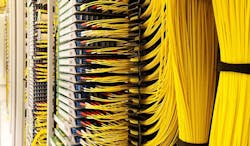Beyond Colo: Equinix Repositions as Digital Infrastructure Company
Equinix is not just about colocation anymore. The company is reinforcing that reality with new branding that positions Equinix as “the world’s digital infrastructure company.”
“It expands our lens and get beyond just colocation and interconnection,” said Jon Lin, the President, Americas for Equinix. “It’s about any of the ways customers can connect to one another, and how companies use digital infrastructure.”
In seeking to move beyond traditional product-based understandings of data center services, Equinix is also looking to forge an identity that encompasses a broader range of offerings, which now includes hyperscale data centers and software-defined connectivity. The company is also pushing into services with its acquisition of Packet and its bare metal cloud services.
Equinix is not alone in this effort, as other leading players are also diversifying and defining platforms that can deliver customer solutions across product categories and geographies. Meanwhile, the COVID-19 pandemic has driven home the critical nature of data centers, which function as a lifeline for the global economy being tied together by digital networks.
The repositioning by Equinix is part of a broader evolution for a mature industry asserting its essential place in the world, and the best way to talk about it.
Digital Leadership as a Customer Magnet
So what’s new in the Equinix messaging? The company’s shift will feature “digital leadership,” both for Equinix and its customers.
“Platform Equinix is where digital leaders bring together all the right places, partners and possibilities they need to succeed,” Equinix says in its new positioning language, which was unveiled to analysts yesterday.
This builds on the Equinix’ belief that companies that embrace a digital transformation of their IT operations will have a competitive advantage, and interconnection will play a central role in that process. This message is particularly timely during the COVID-19 pandemic, which forced many enterprises to lean heavily on digital networks to support a sudden shift to a socially distanced, work-from-home economy.
The repositioning by Equinix is part of a broader evolution for a mature industry asserting its essential place in the world, and the best way to talk about it.
“All of our conversations with customers have reinforced how important it is” to have an agile infrastructure, Lin said. “A lot of them are saying, ‘thank God we did this, or our remote workforce wouldn’t work.’ We’ve been working really hard to accelerate that shift, and there’s a huge segment of enterprises that can benefit from it.”
At the heart of that pitch is the company’s shift from physical network connections to software-defined networking (SDN), offering network capacity that can be configured through a web portal, dramatically simplifying the way data center customers manage their connectivity.
“We see the future as the Equinix Fabric, because it will become the default way people connect with one another in a software-defined, instantaneous fashion,” said Lin. “We expect our customers to find new novel ways to use the fabric.” As an example, Lin said customers are now using the Equinix Cloud Exchange (ECX) Fabric to connect with their supply chain, improving security by reducing the need to provide remote access to third parties.
The Language of Data Center Marketing
Why pay attention to a shift in marketing language? As the largest and most successful colocation provider, Equinix has an outsized voice in conversations about data center services. It was the first data center company to market itself as a platform, which is now a broadly-held aspiration in the industry.
As a colocation specialist, the company historically offered space in cages and cabinets where customers could deploy their own IT equipment. As Equinix moves beyond “power, pipes and ping,” it influences the competitive landscape for other colo providers, further blurring the lines between traditional business models.
To be sure, there are plenty of folks who still pay close attention to the differences between retail colocation, wholesale data centers, and managed services. Heading that list are data center investors, who closely track the different rates of return for different business models, and how they will impact exit strategies and valuation. Public companies like Equinix – which is now a real estate investment trust (REIT) – have more leeway to emphasize a broad portfolio of services with varying rates of return.
The new Equinix marketing reflects an ongoing attempt to reframe how folks talk about data centers. Gartner has advocated retiring the term “data centers,” instead calling these facilities “centers of data” or “centers of data exchange.”
Rest assured, we won’t be changing the name of our publication to “Centers of Data Frontier.” But we’ve been using the term “digital infrastructure” a lot more due to the convergence of data centers with wireless infrastructure, fiber and telecom towers. Several industry conferences have made a similar transition.
“There’s a recognition that we’re trying to expand the conversation beyond colocation and interconnection,” said Lin. “We are the world’s digital infrastructure company. It’s aspirational.”
About the Author


